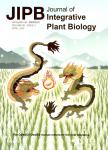Effort and Contribution of T-DNA Insertion Mutant Library for Rice Functional Genomics Research in China:Review and Perspective
Effort and Contribution of T-DNA Insertion Mutant Library for Rice Functional Genomics Research in China:Review and Perspective作者机构:National Key Laboratory of Crop Genetic Improvement and National Center of Plant Gene Research(Wuhan)Huazhong Agricultural University
出 版 物:《Journal of Integrative Plant Biology》 (植物学报(英文版))
年 卷 期:2012年第54卷第12期
页 面:953-966页
核心收录:
学科分类:0710[理学-生物学] 09[农学] 0901[农学-作物学] 0703[理学-化学] 0902[农学-园艺学]
基 金:supported by the National Natural Science Foundation of China(30970172) the 863 Project Grant2012AA10A304 the Program for New Century Excellent Talents in University
主 题:Flanking sequence tags functional genomics insertion site rice T-DNA insertion mutant library.
摘 要:With the completion of the rice (Oryza sativa L.) genome-sequencing project, the rice research community proposed to characterize the func- tion of every predicted gene in rice by 2020. One of the most effective and high-throughput strategies for studying gene function is to employ genetic mutations induced by insertion elements such as T-DNA or transposons. Since 1999, with support from the Ministry of Science and Technology of China for Rice Functional Genomics Programs, large-scale T-DNA insertion mutant populations have been generated in Huazhong Agricultural University, the Chinese Academy of Sciences and the Chinese Academy of Agricultural Sciences. Currently, a total of 372,346 mutant lines have been generated, and 58,226 T-DNA or Tos17 flanking sequence tags have been isolated. Using these mutant resources, more than 40 genes with potential applications in rice breeding have already been identified. These include genes involved in biotic or abiotic stress responses, nutrient metabolism, pollen development, and plant architecture. The functional analysis of these genes will not only deepen our understanding of the fundamental biological questions in rice, but will also offer valuable gene resources for developing Green Super Rice that is high-yielding with few inputs even under the poor growth conditions of many regions of Africa and Asia.



